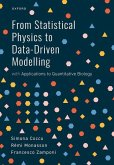David P. Feldman (Department od Physics and College of Mathematics
Chaos and Fractals
An Elementary Introduction
David P. Feldman (Department od Physics and College of Mathematics
Chaos and Fractals
An Elementary Introduction
- Broschiertes Buch
- Merkliste
- Auf die Merkliste
- Bewerten Bewerten
- Teilen
- Produkt teilen
- Produkterinnerung
- Produkterinnerung
For students with a background in elementary algebra, this book provides a vivid introduction to the key phenomena and ideas of chaos and fractals, including the butterfly effect, strange attractors, fractal dimensions, Julia Sets and the Mandelbrot Set, power laws, and cellular automata. The book includes over 200 end-of-chapter exercises.
Andere Kunden interessierten sich auch für
![Introduction to Quantum Field Theory with Applications to Quantum Gravity Introduction to Quantum Field Theory with Applications to Quantum Gravity]() Joseph Buchbinder (Tomsk State P Department of Theoretical PhysicsIntroduction to Quantum Field Theory with Applications to Quantum Gravity53,99 €
Joseph Buchbinder (Tomsk State P Department of Theoretical PhysicsIntroduction to Quantum Field Theory with Applications to Quantum Gravity53,99 €![Measurements and Their Uncertainties Measurements and Their Uncertainties]() Ifan Hughes (University of Durham Department of Physics)Measurements and Their Uncertainties41,99 €
Ifan Hughes (University of Durham Department of Physics)Measurements and Their Uncertainties41,99 €![Introduction to Clifford Algebras and Spinors Introduction to Clifford Algebras and Spinors]() Vaz, Jr., Jayme (Professor of Mat Professor of Mathematical PhysicsIntroduction to Clifford Algebras and Spinors43,99 €
Vaz, Jr., Jayme (Professor of Mat Professor of Mathematical PhysicsIntroduction to Clifford Algebras and Spinors43,99 €![Information, Physics, and Computation Information, Physics, and Computation]() Marc Mezard (Laboratoire de Physique Theorique et Modeles StatistInformation, Physics, and Computation127,99 €
Marc Mezard (Laboratoire de Physique Theorique et Modeles StatistInformation, Physics, and Computation127,99 €![Atomic Pair Distribution Function Analysis Atomic Pair Distribution Function Analysis]() Prof Simon Billinge (Professor of Materials Science and of AppliedAtomic Pair Distribution Function Analysis90,99 €
Prof Simon Billinge (Professor of Materials Science and of AppliedAtomic Pair Distribution Function Analysis90,99 €![From Statistical Physics to Data-Driven Modelling From Statistical Physics to Data-Driven Modelling]() Simona Cocco (Director of Research, Director of Research, CNRS, EcoFrom Statistical Physics to Data-Driven Modelling72,99 €
Simona Cocco (Director of Research, Director of Research, CNRS, EcoFrom Statistical Physics to Data-Driven Modelling72,99 €![Random Tensors Random Tensors]() Razvan Gheorghe Gurau (Researcher, Researcher, Centre de Physique TRandom Tensors121,99 €
Razvan Gheorghe Gurau (Researcher, Researcher, Centre de Physique TRandom Tensors121,99 €-
-
-
For students with a background in elementary algebra, this book provides a vivid introduction to the key phenomena and ideas of chaos and fractals, including the butterfly effect, strange attractors, fractal dimensions, Julia Sets and the Mandelbrot Set, power laws, and cellular automata. The book includes over 200 end-of-chapter exercises.
Hinweis: Dieser Artikel kann nur an eine deutsche Lieferadresse ausgeliefert werden.
Hinweis: Dieser Artikel kann nur an eine deutsche Lieferadresse ausgeliefert werden.
Produktdetails
- Produktdetails
- Verlag: Oxford University Press
- Seitenzahl: 432
- Erscheinungstermin: 12. Oktober 2012
- Englisch
- Abmessung: 246mm x 189mm x 32mm
- Gewicht: 820g
- ISBN-13: 9780199566440
- ISBN-10: 0199566445
- Artikelnr.: 36052915
- Herstellerkennzeichnung
- Libri GmbH
- Europaallee 1
- 36244 Bad Hersfeld
- gpsr@libri.de
- Verlag: Oxford University Press
- Seitenzahl: 432
- Erscheinungstermin: 12. Oktober 2012
- Englisch
- Abmessung: 246mm x 189mm x 32mm
- Gewicht: 820g
- ISBN-13: 9780199566440
- ISBN-10: 0199566445
- Artikelnr.: 36052915
- Herstellerkennzeichnung
- Libri GmbH
- Europaallee 1
- 36244 Bad Hersfeld
- gpsr@libri.de
David Feldman joined the faculty at College of the Atlantic in 1998, having completed a PhD in Physics at the University of California. He served as Associate Dean for Academic Affairs from 2003 - 2007. At COA Feldman has taught over twenty different courses in physics, mathematics, and computer science. Feldman's research interests lie in the fields of statistical mechanics and nonlinear dynamics. In his research, he uses both analytic and computational techniques. Feldman has authored research papers in journals including Physical Review E, Chaos, and Advances in Complex Systems. In 2011-12 he was a U.S. Fulbright Lecturer in Kigali, Rwanda.
I. Introducing Discrete Dynamical Systems
0: Opening Remarks
1: Functions
2: Iterating Functions
3: Qualitative Dynamics
4: Time Series Plots
5: Graphical Iteration
6: Iterating Linear Functions
7: Population Models
8: Newton, Laplace, and Determinism
II. Chaos
9: Chaos and the Logistic Equation
10: The Buttery Effect
11: The Bifurcation Diagram
12: Universality
13: Statistical Stability of Chaos
14: Determinism, Randomness, and Nonlinearity
III. Fractals
15: Introducing Fractals
16: Dimensions
17: Random Fractals
18: The Box-Counting Dimension
19: When do Averages exist?
20: Power Laws and Long Tails
20: Introducing Julia Sets
21: Infinities, Big and Small
IV. Julia Sets and The Mandelbrot Set
22: Introducing Julia Sets
23: Complex Numbers
24: Julia Sets for f(z) = z2 + c
25: The Mandelbrot Set
V. Higher-Dimensional Systems
26: Two-Dimensional Discrete Dynamical Systems
27: Cellular Automata
28: Introduction to Differential Equations
29: One-Dimensional Differential Equations
30: Two-Dimensional Differential Equations
31: Chaotic Differential Equations and Strange Attractors
VI. Conclusion
32: Conclusion
VII. Appendices
A: Review of Selected Topics from Algebra
B: Histograms and Distributions
C: Suggestions for Further Reading
0: Opening Remarks
1: Functions
2: Iterating Functions
3: Qualitative Dynamics
4: Time Series Plots
5: Graphical Iteration
6: Iterating Linear Functions
7: Population Models
8: Newton, Laplace, and Determinism
II. Chaos
9: Chaos and the Logistic Equation
10: The Buttery Effect
11: The Bifurcation Diagram
12: Universality
13: Statistical Stability of Chaos
14: Determinism, Randomness, and Nonlinearity
III. Fractals
15: Introducing Fractals
16: Dimensions
17: Random Fractals
18: The Box-Counting Dimension
19: When do Averages exist?
20: Power Laws and Long Tails
20: Introducing Julia Sets
21: Infinities, Big and Small
IV. Julia Sets and The Mandelbrot Set
22: Introducing Julia Sets
23: Complex Numbers
24: Julia Sets for f(z) = z2 + c
25: The Mandelbrot Set
V. Higher-Dimensional Systems
26: Two-Dimensional Discrete Dynamical Systems
27: Cellular Automata
28: Introduction to Differential Equations
29: One-Dimensional Differential Equations
30: Two-Dimensional Differential Equations
31: Chaotic Differential Equations and Strange Attractors
VI. Conclusion
32: Conclusion
VII. Appendices
A: Review of Selected Topics from Algebra
B: Histograms and Distributions
C: Suggestions for Further Reading
I. Introducing Discrete Dynamical Systems
0: Opening Remarks
1: Functions
2: Iterating Functions
3: Qualitative Dynamics
4: Time Series Plots
5: Graphical Iteration
6: Iterating Linear Functions
7: Population Models
8: Newton, Laplace, and Determinism
II. Chaos
9: Chaos and the Logistic Equation
10: The Buttery Effect
11: The Bifurcation Diagram
12: Universality
13: Statistical Stability of Chaos
14: Determinism, Randomness, and Nonlinearity
III. Fractals
15: Introducing Fractals
16: Dimensions
17: Random Fractals
18: The Box-Counting Dimension
19: When do Averages exist?
20: Power Laws and Long Tails
20: Introducing Julia Sets
21: Infinities, Big and Small
IV. Julia Sets and The Mandelbrot Set
22: Introducing Julia Sets
23: Complex Numbers
24: Julia Sets for f(z) = z2 + c
25: The Mandelbrot Set
V. Higher-Dimensional Systems
26: Two-Dimensional Discrete Dynamical Systems
27: Cellular Automata
28: Introduction to Differential Equations
29: One-Dimensional Differential Equations
30: Two-Dimensional Differential Equations
31: Chaotic Differential Equations and Strange Attractors
VI. Conclusion
32: Conclusion
VII. Appendices
A: Review of Selected Topics from Algebra
B: Histograms and Distributions
C: Suggestions for Further Reading
0: Opening Remarks
1: Functions
2: Iterating Functions
3: Qualitative Dynamics
4: Time Series Plots
5: Graphical Iteration
6: Iterating Linear Functions
7: Population Models
8: Newton, Laplace, and Determinism
II. Chaos
9: Chaos and the Logistic Equation
10: The Buttery Effect
11: The Bifurcation Diagram
12: Universality
13: Statistical Stability of Chaos
14: Determinism, Randomness, and Nonlinearity
III. Fractals
15: Introducing Fractals
16: Dimensions
17: Random Fractals
18: The Box-Counting Dimension
19: When do Averages exist?
20: Power Laws and Long Tails
20: Introducing Julia Sets
21: Infinities, Big and Small
IV. Julia Sets and The Mandelbrot Set
22: Introducing Julia Sets
23: Complex Numbers
24: Julia Sets for f(z) = z2 + c
25: The Mandelbrot Set
V. Higher-Dimensional Systems
26: Two-Dimensional Discrete Dynamical Systems
27: Cellular Automata
28: Introduction to Differential Equations
29: One-Dimensional Differential Equations
30: Two-Dimensional Differential Equations
31: Chaotic Differential Equations and Strange Attractors
VI. Conclusion
32: Conclusion
VII. Appendices
A: Review of Selected Topics from Algebra
B: Histograms and Distributions
C: Suggestions for Further Reading








